Msi 945GM5, 945GZM5, 945GCM5 user Manual
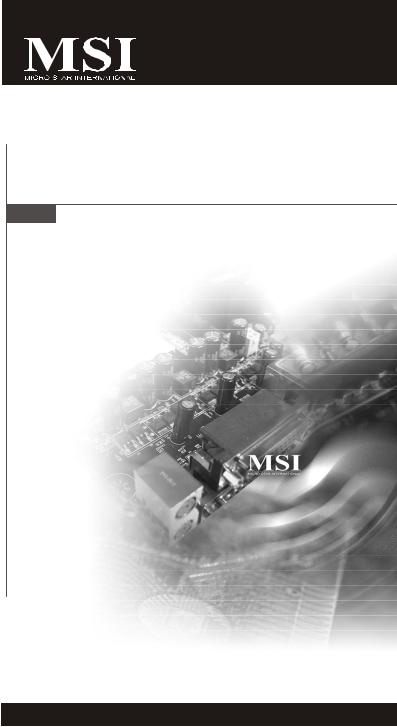
945GM5/ 945GCM5/ 945GZM5 Series
MS-7267 (V4.X) Mainboard
G52-72671XD
i

Copyright Notice
The material in this document is the intellectual property of M ICRO-STAR INTERNATIONAL. We take every care in the preparation of this document, but no guarantee is given as to the correctness of its contents. Our products are under continual improvement and we reserve the right to make changes without notice.
Trademarks
All trademarks are the properties of their respective owners.
NVIDIA, the NVIDIA logo, DualNet, and nForce are registered trademarks or trademarks of NVIDIA Corporation in the United States and/or other countries.
AMD, Athlon™, Athlon™ XP, Thoroughbred™, and Duron™ are registered trademarks of AMD Corporation.
Intel® and Pentium® are registered trademarks of Intel Corporation.
PS/2 and OS®/2 are registered trademarks of International Business Machines Corporation.
Windows® 95/98/2000/NT/XP are registered trademarks of Microsoft Corporation. Netware® is a registered trademark of Novell, Inc.
Award® is a registered trademark of Phoenix Technologies Ltd. AMI® is a registered trademark of American Megatrends Inc.
Revision History
Revision |
Revision History |
Date |
V4.0 |
First release for PCB 4.X |
December 2006 |
|
with Intel 945G/GC/GZ & ICH7 |
|
Technical Support
If a problem arises with your system and no solution can be obtained from the user’s manual, please contact your place of purchase or local distributor. Alternatively, please try the following help resources for further guidance.
 Visit the MSI website for FAQ, technical guide, BIOS updates, driver updates, and other information: http://www.msi.com.tw/program/service/faq/ faq/esc_faq_list.php
Visit the MSI website for FAQ, technical guide, BIOS updates, driver updates, and other information: http://www.msi.com.tw/program/service/faq/ faq/esc_faq_list.php
 Contact our technical staff at: support@msi.com.tw
Contact our technical staff at: support@msi.com.tw
ii

Safety Instructions
1.Always read the safety instructions carefully.
2.Keep this User’s Manual for future reference.
3.Keep this equipment away from humidity.
4.Lay this equipment on a reliable flat surface before setting it up.
5.The openings on the enclosure are for air convection hence protects the equipment from overheating. DO NOT COVER THE OPENINGS.
6.Make sure the voltage of the power source and adjust properly 110/220V before connecting the equipment to the power inlet.
7.Place the power cord such a way that people can not step on it. Do not place anything over the power cord.
8.Always Unplug the Power Cord before inserting any add-on card or module.
9.All cautions and warnings on the equipment should be noted.
10.Never pour any liquid into the opening that could damage or cause electrical shock.
11.If any of the following situations arises, get the equipment checked by a service personnel:
†The power cord or plug is damaged.
†Liquid has penetrated into the equipment.
†The equipment has been exposed to moisture.
†The equipment has not work well or you can not get it work according to User’s Manual.
†The equipment has dropped and damaged.
†The equipment has obvious sign of breakage.
12.DONOT LEAVETHIS EQUIPMENT INANENVIRONMENT UNCONDITIONED, STORAGE TEMPERATURE ABOVE 600 C (1400F), IT MAYDAMAGE THE EQUIPMENT.
CAUTION: Danger of explosion if battery is incorrectly replaced. Replace only with the same or equivalent type recommended by the manufacturer.
iii

FCC-B Radio Frequency Interference Statement
This equipment has been tested and found to comply with the limits for a Class B digital device, pursuant to Part
15 of the FCC Rules. These limits are designed to provide reasonable protection against harmful interference in a residential installation. This equipment generates, uses and can radiate radio frequency energy and, if not installed and used in accordance with the instructions, may cause harmful interference to radio communications. However, there is no guarantee that interference will not occur in a particular installation. If this equipment does cause harmful interference to radio or television reception, which can be determined by turning the equipment off and on, the user is encouraged to try to correct the interference by one or more of the measures listed below.
†Reorient or relocate the receiving antenna.
†Increase the separation between the equipment and receiver.
†Connect the equipment into an outlet on a circuit different from that to which the receiver is connected.
†Consult the dealer or an experienced radio/television technician for help.
Notice 1
The changes or modifications not expressly approved by the party responsible for compliance could void the user’s authority to operate the equipment.
Notice 2
Shielded interface cables and A.C. power cord, if any, must be used in order to comply with the emission limits.
VOIR LANOTICE D’INSTALLATIONAVANTDE RACCORDER AU RESEAU.
Micro-Star International
MS-7267
This device complies with Part 15 of the FCC Rules. Operation is subject to the following two conditions:
(1)this device may not cause harmful interference, and
(2)this device must accept any interference received, including interference that may cause undesired operation.
iv

WEEE (Waste Electrical and Electronic Equipment) Statement
v

vi

vii
CONTENTS |
|
Copyright Notice ............................................................................................................... |
ii |
Trademarks ....................................................................................................................... |
ii |
Revision History ............................................................................................................... |
ii |
Technical Support ............................................................................................................ |
ii |
Safety Instructions .......................................................................................................... |
iii |
FCC-B Radio Frequency Interference Statement ........................................................ |
iv |
WEEE Statement .............................................................................................................. |
v |
Chapter 1. Getting Started .................................................................................... |
1-1 |
Mainboard Specifications ................................................................................... |
1-2 |
Mainboard Layout ................................................................................................ |
1-4 |
Packing Checklist ................................................................................................. |
1-5 |
MSI Special Feature ............................................................................................ |
1-6 |
Chapter 2. Hardware Setup .................................................................................. |
2-1 |
Quick Components Guide .................................................................................... |
2-2 |
CPU (Central Processing Unit) ............................................................................ |
2-3 |
Introduction to LGA 775 CPU ...................................................................... |
2-3 |
CPU & Cooler Installation ............................................................................. |
2-4 |
Memory................................................................................................................. |
2-7 |
Installing DDRII Modules ............................................................................... |
2-8 |
Power Supply ...................................................................................................... |
2-9 |
ATX 24-Pin Power Connector: ATX1 ......................................................... |
2-9 |
ATX 12V Power Connector: PWRCONN1 ................................................. |
2-9 |
Back Panel .......................................................................................................... |
2-10 |
Connectors ........................................................................................................ |
2-12 |
Floppy Disk Drive Connector: FDD2 .......................................................... |
2-12 |
Hard Disk Connector: IDE1 ........................................................................ |
2-12 |
Serial ATA Connectors: SATA1~SATA4 ................................................... |
2-13 |
Fan Power Connectors: CPUFAN1, SYSFAN1&PWRFAN1..................... |
2-14 |
Chassis Intrusion Switch Connector: JCI2 .............................................. |
2-14 |
CD-In Connector: CD_IN1 .......................................................................... |
2-15 |
Front Panel Connectors: JFP1 / JFP2 ...................................................... |
2-15 |
Front Panel Audio Connector: JAUD1 ...................................................... |
2-16 |
SPDIF-Out Connector: JSPD1 (Optional, for HDMI graphics card only) 2-16 |
|
Front USB Connectors: JUSB1 / JUSB2 .................................................. |
2-17 |
Serial Port Connector: JCOM1 (optional) ................................................. |
2-18 |
Jumpers .............................................................................................................. |
2-19 |
Clear CMOS Jumper: JBAT1 ..................................................................... |
2-19 |
viii
Slots .................................................................................................................... |
2-20 |
PCI Express Slots ...................................................................................... |
2-20 |
PCI (Peripheral Component Interconnect) Slots ...................................... |
2-20 |
PCI Interrupt Request Routing ................................................................... |
2-21 |
Chapter 3. BIOS Setup ............................................................................................ |
3-1 |
Entering Setup ..................................................................................................... |
3-2 |
Control Keys ................................................................................................ |
3-3 |
Getting Help .................................................................................................. |
3-3 |
General Help <F1> ....................................................................................... |
3-3 |
The Main Menu ..................................................................................................... |
3-4 |
Standard CMOS Features ................................................................................... |
3-6 |
Advanced BIOS Features ................................................................................... |
3-9 |
Integrated Peripherals ....................................................................................... |
3-12 |
Power Management Setup ............................................................................... |
3-14 |
PNP/PCI Configurations ..................................................................................... |
3-17 |
H/W Monitor ........................................................................................................ |
3-19 |
Frequency/Voltage Control ............................................................................... |
3-20 |
Load Fail-Safe/ Optimized Defaults ................................................................. |
3-22 |
BIOS Setting Password ..................................................................................... |
3-24 |
Appendix A Realtek ALC883/888 Audio ............................................................. |
A-1 |
Installing the Realtek HD Audio Driver ................................................................ |
A-2 |
Installation for Windows 2000/XP .............................................................. |
A-2 |
Software Configuration ...................................................................................... |
A-4 |
Sound Effect ................................................................................................ |
A-5 |
Mixer ............................................................................................................. |
A-8 |
Audio I/O ..................................................................................................... |
A-12 |
Microphone ................................................................................................ |
A-16 |
3D Audio Demo ........................................................................................... |
A-17 |
Information.................................................................................................. |
A-18 |
Hardware Setup ................................................................................................ |
A-19 |
ix

Getting Started
Chapter 1
Getting Started
Thank you for choosing the 945GM5/ 945GCM 5/ 945GZM5 Series (MS-7267 v4.X) Micro-ATX mainboard. The 945GM5/ 945GCM5/ 945GZM5 Series mainboard is based on Intel® 945G/ 945GC/ 945GZ and Intel® ICH7 chipset for optimal system efficiency. Designed to fit the advanced Intel® Pentium 4 Series LGA775 processor, the 945GM5/ 945GCM5/ 945GZM5 Series mainboard delivers a high performance and professional desktop platform solution.
1-1
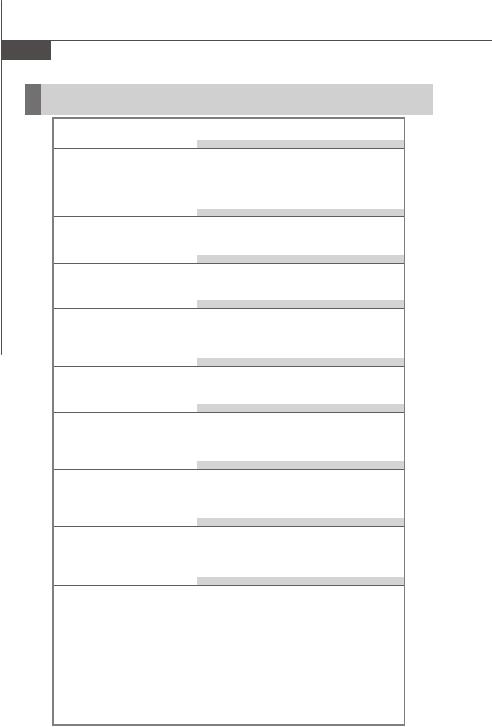
MS-7267 Mainboard
Mainboard Specifications
 Processor Support
Processor Support
- Intel® Core 2 Duo/ Pentium D/ Pentium 4/ Celeron Series processors in the LGA775 package.
For the latest information about CPU, please visit http://www.msi.com.tw/ program/products/mainboard/mbd/pro_mbd_cpu_support.php
 Supported FSB
Supported FSB
-1066/ 800/ 533 MHz (for 945GM5 series)
-800/ 533 MHz (for 945GCM5/ 945GZM5 series)
 Chipset
Chipset
-North Bridge: Intel® 945G/ 945GC/ 945GZ chipset
-South Bridge: Intel® ICH7 chipset
 Memory Support
Memory Support
-DDRII 400/ 533/ 667 SDRAM (4 GB Max, for 945GM5 series)
-DDRII 400/ 533 SDRAM (2 GB Max, for 945GCM5/ 945GZM5 series)
-2 DDRII DIMMs (240pin / 1.8V)
 LAN (optional)
LAN (optional)
-Supports 10/100/1000 Fast Ethermet by Realtek 8111B
-Or supports 10/100 Fast Ethermet by Realtek 8101E
 Audio
Audio
-High Definition link controller integrated in Intel® ICH7 chip
-7.1 channels audio codec Realtek ALC883/ ALC888
-Compliant with Azalia 1.0 Spec
 IDE
IDE
-1 IDE port by ICH7
-Supports Ultra DMA 66/100 mode
-Supports PIO, Bus Master operation mode
 SATA
SATA
-Four SATA ports by ICH7
-Supports four SATA II devices
-Supports storage and data transfers at up to 300MB/s
 Floppy
Floppy
-1 floppy port
-Supports 1 FDD with 360K, 720K, 1.2M, 1.44M and 2.88Mbytes
1-2

Getting Started
Connectors
 Back panel
Back panel
-1 PS/2 mouse port
-1 PS/2 keyboard port.
-1 serial port
-1 parallel port supporting SPP/EPP/ECP mode
-1 VGA port
-4 USB 2.0 Ports
-1 LAN jack
-6 audio jacks
 On-Board Pinheaders
On-Board Pinheaders
-1 COM2 pinheader
-1 case intrusion pinheader
-2 USB 2.0 pinheaders
-1 SPDIF-out pinheader (for HDMI Graphic card only)
Slots
-1 PCI Express x16 slot(for 945GM5/ 945GCM5 series only)
-1 PCI Express x1 slot
-2 PCI slots (Support 3.3V/ 5V PCI bus Interface)
Form Factor
- Micro-ATX (24.5cm X 22.0 cm)
Mounting
- 6 mounting holes
1-3
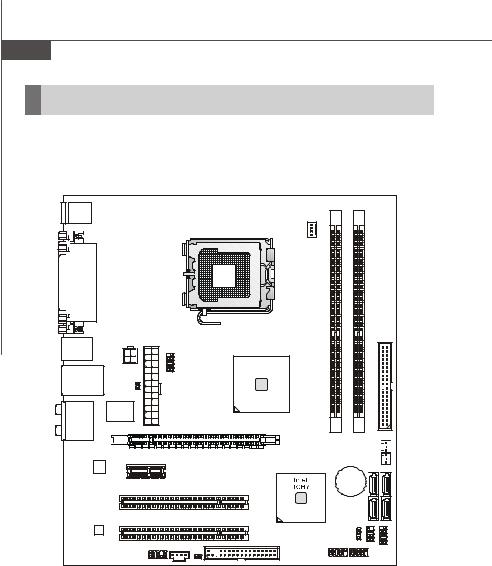
MS-7267 Mainboard
Mainboard Layout
Top : mouse |
|
|
|
|
Bottom: |
|
|
|
|
keyboard |
|
|
|
|
Top : |
|
|
|
|
Parallel Port |
|
|
|
|
Bottom: |
|
|
|
|
COM portA |
|
|
|
|
VGA port |
|
|
|
|
USB ports |
PWRCONN1 |
|
|
|
|
JCOM1 |
|
||
|
|
|
|
Intel |
Top: LAN Jack |
|
|
|
945G/ GC/ GZ |
|
|
|
|
|
Bottom: USB ports |
|
|
|
|
|
JCI2 |
|
|
|
T:Line-In |
I/O |
ATX1 |
|
|
M:Line-Out |
|
|
||
B:Mic |
Chip |
|
|
|
|
|
|
||
T:RS-Out |
|
|
|
|
M:CS-Out |
|
|
|
|
B:SS-Out |
|
|
|
|
|
PCI_E1 (For 945GM5/ 945GCMG series only) |
|||
LAN Chip |
|
|
|
|
|
PCI _E2 |
|
|
|
|
PCI2 |
|
|
|
Codec |
|
|
|
|
|
PCI1 |
JAUD1 |
CD_IN1 |
|
|
|
|
JSPD1 |
FDD2 |
CPUFAN1
DIMM1 |
DIMM2 |
IDE 1
SYSFAN1
PWRFAN1 

BATT |
SATA3 |
SATA4 |
|
+ |
|
SATA1 |
SATA2 |
JBAT1 |
JFP1 |
|
JFP2 |
JUSB2 JUSB1 |
|
945GM5/ 945GCM5/ 945GZM5 (MS-7267 V4.X) Series Micro-ATX Mainboard
1-4
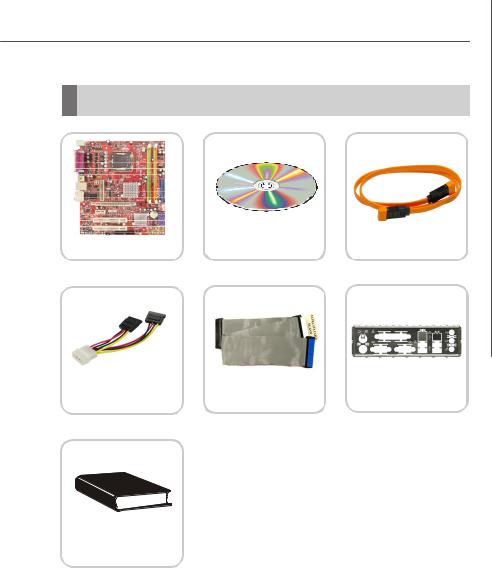
Getting Started
Packing Checklist
MSI motherboard |
MSI Driver/Utility CD |
SATA Cable (optional) |
|
|
Power Cable |
Standard Cable for |
Back IO Shield |
IDE Devices (optional) |
|
User’s Guide
* The pictures are for reference only and may vary from the packing contents of the product you purchased.
1-5
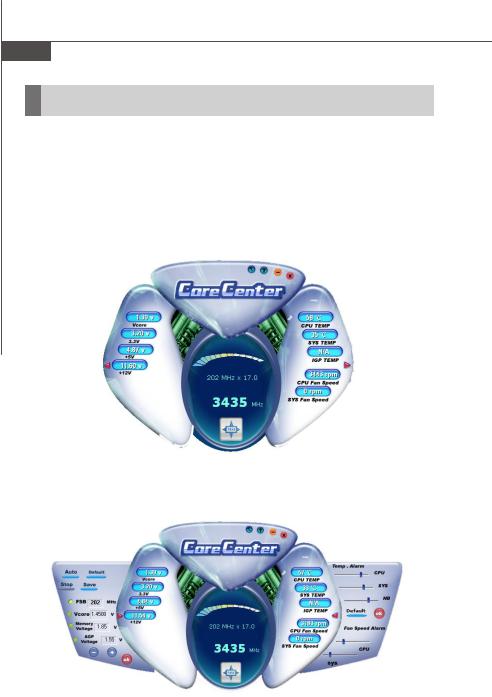
MS-7267 Mainboard
MSI Special Feature
Core Center
The Core Center is a new utility you can find in the CD-ROM disk. The utility is just like your PC doctor that can detect, view and adjust the PC hardware and system status during real time operation.
In the left side it shows the current system status including the Vcore, 3.3V, +5V and 12V. In the right side it shows the current PC hardware status such as the CPU & system temperatures and all fans speeds.
When you click the red triangles in the left and right sides, two sub-menus will open for users to adjust the thresholds of system to send out the warning messages.
1-6

Getting Started
Left-wing: Current system status
In the left sub-menu, you can configure the settings of FSB, Vcore, Memory Voltage and AGP Voltage by clicking the radio button next to each item and make it available (the radio button will be lighted as yellow when selected), use the “+” and “-” buttons to adjust, then click “OK” to apply the changes. Then you can click “Save” to save the values you just configured.
Also you may click “Auto” to start testing the maximum CPU overclocking value. The CPU FSB will automatically increase the testing value until the PC reboots. Or you may click “Default” to restore the default values.
Right-wing: PC hardware status during real time operation
In the right sub-menu, here you can configure the PC hardware status such as CPU & system temperatures and fan speeds. You may use the scroll bars to adjust each item, then click “OK” to apply the changes. The values you set for the temperatures are the maximum thresholds for the system for warnings, and the value for fan speeds are the minimum thresholds.
1-7

Hardware Setup
Chapter 2
Hardware Setup
This chapter provides you with the information about hardware setup procedures. While doing the installation, be careful in holding the components and follow the installation procedures. For some components, if you install in the wrong orientation, the components will not work properly.
Use a grounded wrist strap before handling computer components. Static elec tric ity may damage the components.
2-1
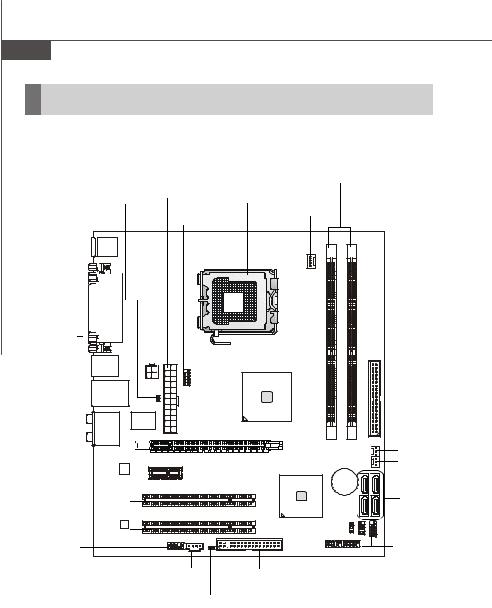
MS-7267 Mainboard
Quick Components Guide
PWRCONN1, p.2-9 |
|
DIMM1/2, p.2-7 |
|
|
|
|
|
JCI2,p2-14 |
ATX1,p.2-9 |
CPU, p.2-3 |
CPUFAN1, |
|
|
|
|
|
JCOM1, |
|
p2-14 |
|
p.2-18 |
|
|
BackPanel, |
|
|
|
p.2-10 |
|
|
|
|
|
|
IDE 1 , |
|
|
|
p.2-12 |
PCIE_X16, |
|
|
SYSFAN1, |
p.2-20 |
|
|
p.2-14 |
PCI 1~3, |
|
|
PWRFAN1, |
|
|
p.2-14 |
|
p.2-21 |
|
|
|
|
|
|
SATA1~4, |
|
|
|
p.2-13 |
JAUD1, |
|
|
JFP1/JFP2, |
|
|
p.2-15 |
|
p.2-16 |
|
|
|
|
|
|
|
|
CD_IN1, |
FD D 2 , |
JUSB1/2, |
|
p.2-15 |
p.2-12 |
|
|
JSPD1, |
|
p.2-17 |
|
|
|
|
|
p.2-16 |
|
JBAT1, p.2-19 |
|
|
|
|
2-2 |
|
|
|
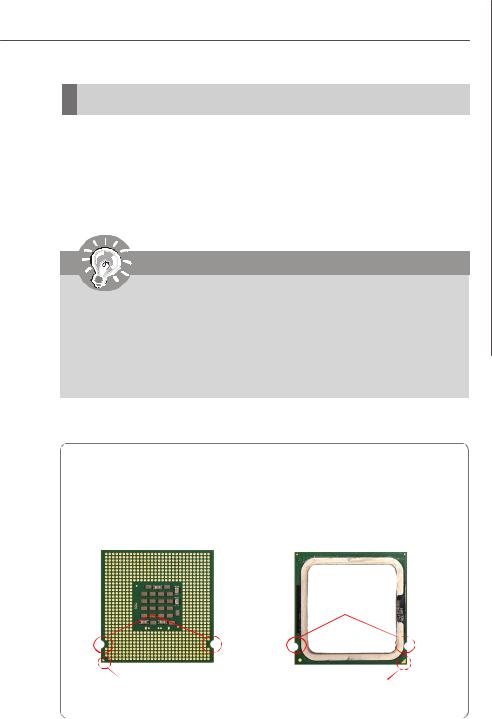
Hardware Setup
CPU (Central Processing Unit)
The mainboard supports Intel® Pentium 4 series processors. The mainboard uses a CPU socket called LGA775. When you are installing the CPU, make sure to install the cooler to prevent overheating. If you do not have the CPU cooler, contact your dealer to purchase and install them before turning on the computer.
For the latest information about CPU, please visit http://www.msi.com.tw/program/ products/mainboard/mbd/pro_mbd_cpu_support.php
Important
1.Overheating will seriously damage the CPU and system. Always make sure the cooling fan can work properly to protect the CPU from overheating.
2.Make sure that you apply an even layer of heat sink paste (or thermal tape) between the CPU and the heatsink to enhance heat dissipation.
3.While replacing the CPU, always turn off the ATX power supply or unplug the power supply’s power cord from the grounded outlet first to ensure the safety of CPU.
Introduction to LGA 775 CPU
The pin-pad side of LGA 775 CPU.
The surface of LGA 775 CPU. Remember to apply some silicone heat transfer compound on it for better heat dispersion.
Alignment Key |
Alignment Key |
Yellow triangle is the Pin 1 indicator |
Yellow triangle is the Pin 1 indicator |
|
2-3
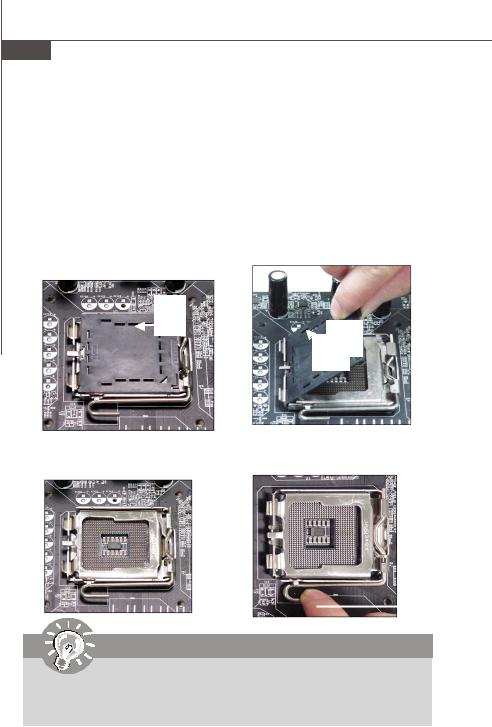
MS-7267 Mainboard
CPU & Cooler Installation
When you are installing the CPU, make sure the CPU has a cooler attached on the top to prevent overheating. If you do not have the cooler, contact your dealer to purchase and install them before turning on the computer. Meanwhile, do not forget to apply some silicon heat transfer compound on CPU before installing the heat sink/ cooler fan for better heat dispersion.
Follow the steps below to install the CPU & cooler correctly. Wrong installation will cause the damage of your CPU & mainboard.
1.The CPU socket has a plastic cap on it to protect the contact from damage. Before you install the CPU, always cover it to protect the socket pin.
2.Remove the cap from lever hinge side (as the arrow shows).
3. The pins of socket reveal.
4. Open the load lever.
Important
1.Confirm if your CPU cooler is firmly installed before turning on your system.
2.Do not touch the CPU socket pins to avoid damaging.
3.The availability of the CPU land side cover depends on your CPU packing.
2-4

5.Lift the load lever up and open the load plate.
Hardware Setup
6.After confirming the CPU direction for correct mating, put down the CPU in the socket housing frame. Be sure to grasp on the edge of the CPU base. Note that the alignment keys are matched.
alignment key
7.Visually inspect if the CPU is seated well into the socket. If not, take out the CPU with pure vertical motion and reinstall.
8.Cover the load plate onto the package.
2-5
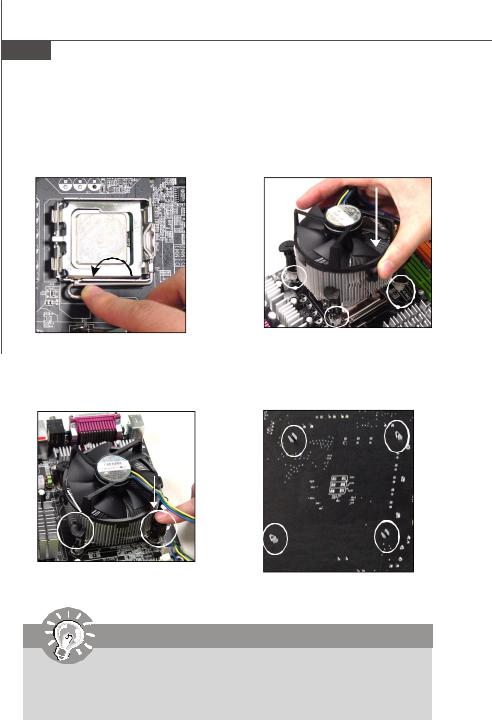
MS-7267 Mainboard
9.Press down the load lever lightly onto the load plate, and then secure the lever with the hook under retention tab.
11.Press the four hooks down to fasten the cooler. Then rotate the locking switch (refer to the correct direction marked on it) to lock the hooks.
locking switch
10.Align the holes on the mainboard with the heatsink. Push down the cooler until its four c lips get wedged into the holes of the mainboard.
12.Turn over the mainboard to confirm that the clip-ends are correctly inserted.
Important
1.Check the information in BIOS (Chapter 3) for the CPU temperature.
2.Whenever CPU is not installed, always protect your CPU socket pin with the plastic cap covered (shown in Figure 1) to avoid damaging.
2-6

Hardware Setup
Memory
The mainboard provides two 240-pin non-ECC DIMMs and supports dual-channel technology up to 2GB system memory.
For more information on compatible components, please visit http://www.msi.com.tw/ program/products/mainboard/mbd/pro_mbd_trp_list.php
DDRII
240-pin, 1.8V
56x2=112 pin |
64x2=128 pin |
Dual-Channel: Channel A in GREEN; Channel B in ORANGE
Dual-Channel Memory Population Rules
Dual-Channel mode can enhance the performance of the system. Please refer to the following illustration for population rules under Dual-Channel mode.
 DIMM1
DIMM1
 DIMM2
DIMM2
Important
-DDRII modules are not interchangeable with DDR and the DDR2 standard is not backwards compatible. You should always install DDR2 memory modules in the DDR2 DIMM slots.
-In dual-channel mode, make sure that you install memory modules of the
same type and density in different channel DDR DIMM slots.
-To enable successful system boot-up, always insert the memory modules into the DIMM1 first.
-Due to the chipset resource deployment, the system density will only be detected up to 1+GB (not full 2GB) when each DIMM is installed with a 1GB memory module.
2-7
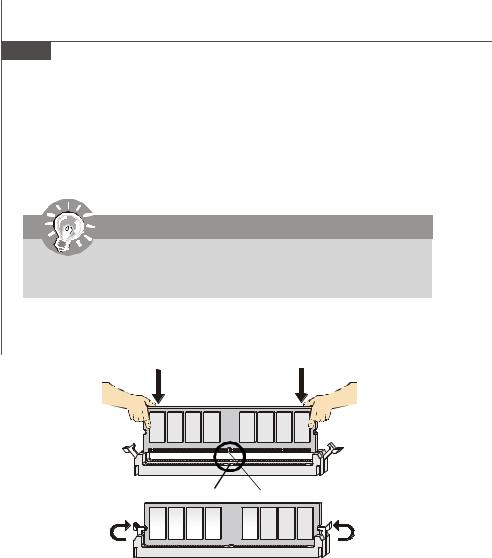
MS-7267 Mainboard
Installing DDR2 Modules
1.The memory module has only one notch on the center and will only fit in the right orientation.
2.Insert the DIMM memory module vertically into the DIMM slot. Then push it in until the golden finger on the memory module is deeply inserted in the socket.
Important
You can barely see the golden finger if the module is properly inserted in the socket.
3. The plastic clip at each side of the DIMM slot will automatically close.
Volt Notch
2-8
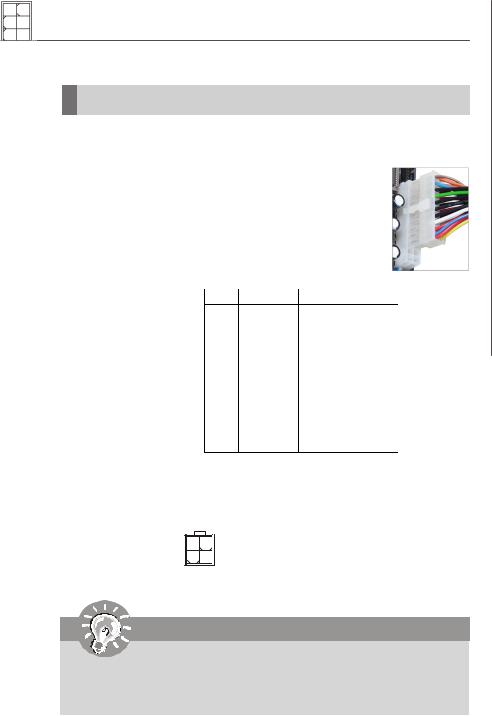
Hardware Setup
Power Supply
ATX 24-Pin Power Connector: ATX1
This connector allows you to connect an ATX 24-pin power supply. To connect the ATX 24-pin power supply, make sure the plug of the power supply is inserted in the proper orientation and the pins are aligned. Then push down the power supply firmly into the connector.
You may use the 20-pin ATX power supply as you like. If you’d like to use the 20-pin ATX power supply, please plug your power supply along with pin 1 & pin 13 (refer to the image at the right hand). There is also a foolproof design on pin 11, 12, 23 & 24 to avoid wrong installation.
Pin Definition
 pin 13
pin 13
 pin 12
pin 12
12 |
24 |
PIN |
SIGNAL |
PIN |
SIGNAL |
|
|
1 |
+3.3V |
13 |
+3.3V |
|
|
2 |
+3.3V |
14 |
-12V |
ATX1 |
|
3 |
GND |
15 |
GND |
|
4 |
+5V |
16 |
PS-ON# |
|
|
|
5 |
GND |
17 |
GND |
|
|
6 |
+5V |
18 |
GND |
|
|
7 |
GND |
19 |
GND |
|
|
8 |
PWROK |
20 |
Res |
|
|
9 |
5VSB |
21 |
+5V |
|
|
10 |
+12V |
22 |
+5V |
1 |
13 |
11 |
+12V |
23 |
+5V |
|
|
12 |
+3.3V |
24 |
GND |
ATX 12V Power Connector: PWRCONN1
This 12V power connector is used to provide power to the CPU.
3 |
4 |
1 |
2 |
PWRCONN1
Pin Definition
PIN |
SIGNAL |
1 |
GND |
2 |
GND |
3 |
12V |
4 |
12V |
Important
1.Maker sure that all the connectors are connected to proper ATX power supplies to ensure stable operation of the mainboard.
2.Power supply of 350 watts (and above) is highly recommended for system stability.
2-9
